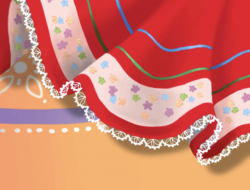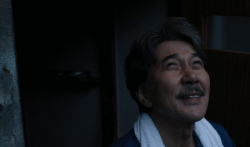Looking out the windows of the National Gallery of Art, a group of well-dressed men in long coats stand in a loose clump, with curious and excited looks on their faces. Strings have been pulled and these men have a chance to meet Andy Goldsworthy. Though he looks slightly distracted, the artist amiably shakes hands with each one, answers some questions with gestures and glances over his shoulder. The men wrap up formalities and thank the artist. These men have just visited Goldsworthy’s world, a world in which many things can be art and process is just as important as product. Inside the museum lobby they chat for a minute, recapping their experience. Their ogling seems more appropriate for the streets of Hollywood than the corridors of a museum. Goldsworthy handles his burgeoning celebrity well, without much visible thought for the wide-eyed onlookers staring in from outside.
British environmental artist Andy Goldsworthy, known for his 25 years of site-specific installations, is currently working in the ground-level garden area of the East building of the National Gallery of Art. His installation, “Roof,” is a series of nine hollow, slate domes, each with a center opening. Goldsworthy is using buckingham slate from a nearby Virginia quarry for the project, alluding to the domes’ architectural cousins, the Smithsonian Castle and the Ford Theater, which both use the same slate. In a city filled with monumental domes, Goldsworthy’s work presents the public with a new take on an ancient form. Rather than gazing upward toward the dome, spectators will look down on them from viewing areas in the museum.
Goldsworthy is best known for his ephemeral works: sculptures built in a day and gone by sunset. This most recent commission at the Gallery is markedly different for Goldsworthy; technically outdoors, his proximity to a building and the urban surroundings make this project unlike most of his previous work.
Goldsworthy can be better understood through the documentary film Rivers and Tides (2001), which follows him through Nova Scotia and Scotland to beaches, forests, meadows and icy mountains, slowly uncovering his methods and philosophies. There are few words in the film, barring contemplative narration by Goldsworthy himself and the explanation he offers as he works.
He makes leaf formations and floats them down rivers. He drops red clay into ponds to make swirls in the water. His driftwood domes float away with the tide. Sharp, naturally lit photographs are all that remain of his art after the hands of time have reclaimed the original elements. A finished product is not the ultimate objective for Goldsworthy; it’s the process of the art and the understanding of the materials that interests him. The beauty of his work lies in its temporal nature. Most of the film is filled with a wistful musical score and expansive shots of nature from afar, some in exaggerated detail. Most interesting are the scenes in which Goldsworthy addresses the camera mid-work and mentions whatever thoughts come to mind.
Goldsworthy is a fascinating character. Coming from someone else, his ideas might sound contrived, but his genuine concern for the issues and curiosity about his mediums lend him an air of earnestness. His musings on mortality and the intentions of his art push him beyond mere artistry toward the strata of philosopher. In the film, while pondering the transient nature of his work, he explains that “the very thing that brings a work to life is the thing to cause its death.” His fascination with water, rivers and tides, as suggested by the title of the film, is embodied in this statement. In a sculpture using broken pieces of icicles, it is the frozen water that is the art, yet it is the very nature of water, in its melting, which heralds the demise of the sculpture. As his art comes and goes, lives and dies, Goldsworthy finds a connection with the earth and life that has gone before.
In an early scene, Goldsworthy arrives on the beach at sunrise with his one cameraman/assistant. He plans to build a pinecone-shaped rock formation on the beach before the tide rises in the afternoon. Goldsworthy stacks rock upon rock until, due to a misplaced stone, the three-foot-high formation collapses into a mound on the sand. Slightly frustrated yet maintaining composure, his reaction is telling. After a quiet “shit,” and a moment of hunched contemplation, Goldsworthy comments to the camera that his connection to the stone was strong, that he was down there with it, but that he just couldn’t see it. In his art he tries to understand his materials and, in a sense, become one with them in order to bring every inherent possibility to life.
The environmental history that marks his newest site on the National Mall is not as unique as some of his more remote sites, but the installation nevertheless aims to connect with life in all possible ways. The domes recall Neolithic burial chambers as well as Roman and Byzantine architecture; they are crude, yet soundly constructed. The dome has been a recurring theme in Goldsworthy’s work, appearing in ice blocks, driftwood and reeds. He reminds us that the dome is a primal form, innate to our nature and architectural past. In the museum, Goldsworthy once again achieves a greater meaning in his art and gets below the surface of understanding beauty and composition.
Back at the National Gallery the artist, dressed casually in jeans, fleece and a white vest, leans on one knee, balancing on the side of a six-foot high slate dome. He gestures to an assistant, points to a stack of loose stones, then steps down and passes by. The glass separating Goldsworthy from onlookers seems to be a one-way barrier-he almost never acknowledges the excited crowd a few feet away. But every once in a while, if a bystander is lucky enough to catch his eye, he may flash a smile and wave. The very nature of the exhibit brings Goldsworthy’s process to a new level. The commission is a fishbowl and Goldsworthy is as much the exhibit as the domes
Goldsworthy frees his mind through his art, and his work not only challenges the eye, but inspires others to follow his lead.
Andy Goldsworthy will be lecturing in the East Building Auditorium at the National Gallery at 12 noon on Sunday, January 23. Rivers and Tides will be showing at 2 pm on Wednesday, January 26 and on Thursday, February 3 and 10 in the Auditorium.




